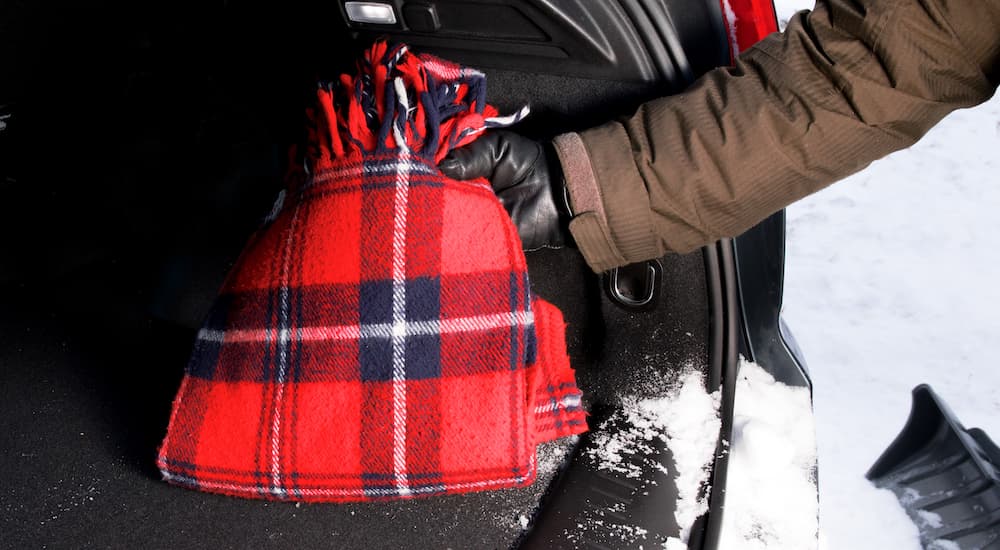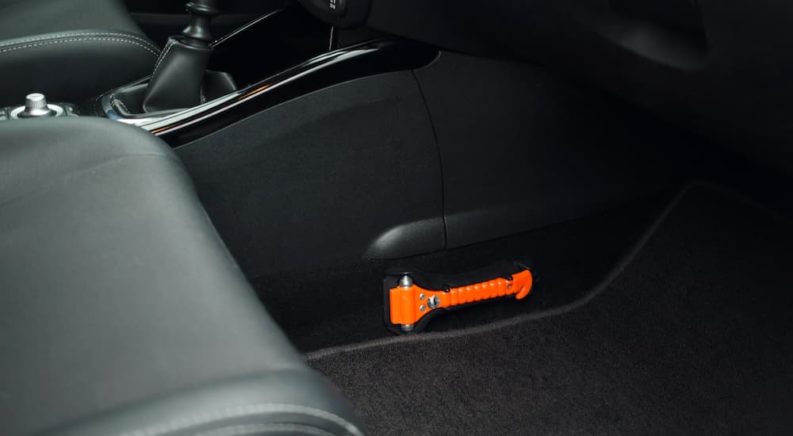Life likes to throw us curveballs, especially when we’re on the road. That’s why it’s important to be prepared. Knowing what emergency equipment to keep in your car can make all the difference when the road gets rough. It’s always a smart idea to keep your vehicle well-equipped with basic emergency tools and supplies and to be informed on how to properly use them.
Seat Belt Cutter and Window Breaker
If you have ever seen a vehicle safety video, you have probably seen a seat belt cutter and a window breaker in action. However, if you are unclear on what these tools are for, they are fairly self-explanatory. A seat belt cutter is used to slice through a seatbelt to free the occupant. If your seat belt becomes stuck and you need to escape, this tool can save your life.
A window breaker is also as it sounds. It is a tool with the job of breaking your vehicle’s window. If you find yourself submerged in water or upside down and need to shatter a window to escape, this tool is what you will need. However, it is important to note that most window breakers only work on tempered glass and will not shatter laminated glass.
For most vehicles, laminated glass is only used for the windshield, while tempered glass is used for side windows. However, higher-end models are increasingly using laminated glass for at least some of the side windows. Do your research and figure out what your windows are made of ahead of time. If your vehicle has all laminated glass, don’t fret. While a glass breaker may not work, there are glass cutter tools that can work on laminated glass in times of emergency. Just make sure to get the right tool for your vehicle.
A Spare, a Jack, and a Key
Many of us have had a flat at one time or another. If you haven’t had the misfortune, count yourself lucky and plan ahead by always including a spare and a jack in your vehicle. Most vehicles come standard with a spare, but if you don’t have one, get one. Even if you have roadside service or a tow truck on speed dial, you may find yourself in a situation where a spare tire is your best bet––especially if you travel in remote areas where cell service isn’t guaranteed.
You won’t be able to swap out a tire without the proper tools, so make sure to invest in a proper jack if you don’t already have one. They come in different styles and vary in difficulty of use, so shop around and find one that works for you. You will also need a lug wrench. Check to see if your vehicle comes with one. If not, make sure to get the right one for your lug nuts. They are not a “one size fits all” type of tool.
One thing to keep in mind when considering what you will need in case of a flat is whether or not your vehicle has wheel locks. A wheel lock is an individualized lug nut that requires a special socket to remove. This is a great anti-theft measure, but if you find yourself on the side of the road with a flat, a wheel lock, and no key…well, let’s just say it’s easier to make sure you have the key before getting on the road and testing your luck.
Portable Jump Starter
A dead battery is an easy enough fix if you have the right tools. Keeping either jumper cables or a portable jump starter in your vehicle can save you in a bind. In the past, the only real option to jumpstart a battery was to flag someone down and use jumper cables to get a boost from their vehicle. This is still a viable method to get you on the road again.
However, things have improved a lot in the last decade, and now portable jump starters are more affordable and accessible than before. Portable jump starters remove the other car from the equation and allow you to give your battery the boost it needs without depending on someone else. Keep either or both in your vehicle to be prepared for a dead battery.
Emergency Reflectors or Road Flares
Emergency reflectors come in different styles but are often triangular devices made of highly reflective material. These are great to use at nighttime to draw attention to your vehicle in case of an emergency and protect yourself from oncoming traffic. If you do not have emergency reflectors or live in an area prone to bad weather and low visibility, road flares are a good alternative.
Road flairs can alert emergency personnel to your location in low visibility situations and can also alert other vehicles, keeping you safe. It’s important to remember that road flares are a fire hazard and should be used responsibly. Keep them away from gasoline and other flammable materials, and only use them in the case of an emergency.
First Aid Kit
Having a fully stocked and up-to-date first aid kit can be one of the best tools to keep in your vehicle. First aid kits range in price and quality and can be found almost anywhere. Choose one that fits your vehicle and your needs. You may not need one that is top-of-the-line, especially if you usually travel in populated areas where help is close at hand. We always recommend familiarizing yourself with the contents of the kit and getting some basic first-aid training so you know what to do in an emergency.
A first aid kit is a great place to keep emergency medications as well. If you have anyone in the family with severe allergies, consider keeping an EpiPen or other necessary medications in your first aid kit, just in case. Also, keep in mind that the supplies in a first aid kit can expire, so don’t use old and out-of-date kits, and check them occasionally to see if you need to refill, replace, or toss anything.

Flashlight and Batteries
If you have ever been stuck at night, you know how important a flashlight can be. A flashlight should be a staple in your vehicle tool kit, whether it is to shine a light on any repair work you might be doing or to try and flag someone down (safely, of course, do not shine it directly at oncoming traffic). Make sure you have an extra set of fresh batteries, just in case. You may even consider a headlamp for hands-free repair work. While you can use your phone for light, a flashlight will be brighter and last longer.
Phone Charger
Keep a phone charger with you in case you run low on battery and need to call out for help. Phone chargers take up very little room and can be stashed away in the glove compartment. For extra assistance, consider a rechargeable energy bank. This way, you can charge your phone even if your vehicle dies. Many portable jump starters double as a phone charger, so look for that feature to save space.
Tool Kit
Everyone should have a basic tool kit, especially for their vehicle. You never know what situation you might face, so keeping tools and supplies like gloves, a tire pressure gauge, an ice scraper, and even a tire patch kit can make a huge difference. Duct tape is a great product to keep in your vehicle and can come in handy in a variety of situations.
Food and Water
Keeping a jug of water and some non-perishable food in your vehicle is a fantastic idea, no matter your situation. Power bars, nuts, dried fruit, or any other long-lasting food should be included in your emergency kit. Plus, keeping a jug of water not only helps you stay hydrated but can even be attached to a flashlight to work as a lantern. Who knew?
Prepping Your Car for Winter Emergencies
If you live in an area where you regularly face snowstorms and icy roads, you will want to include some extra items in your emergency kit during the winter. These items could be lifesaving if your car gets stuck in freezing temperatures.
Traction Mat or Cat Litter
This item is ideal for those who live in snowy or icy weather but can also apply to muddy and soft terrain. Yes, you read that correctly; it does say cat litter. Keeping a traction mat in your vehicle can get you out of a jam. However, if you don’t have one, cat litter can work in a similar fashion. A traction mat provides on-demand traction aid. If you find yourself stuck in mud, snow, or ice, you can use a traction mat to gain extra grip and get your vehicle unstuck. Another traditional alternative is a bag of sand, but if that rips, cleaning your car will be a nightmare.
Collapsible Shovel
Again, this item is directed primarily at those who live in cold climates but can help if you get stuck in mud or dirt as well. A collapsible shovel doesn’t take up much room but can help you literally dig yourself out of trouble. If you find yourself buried deep in a snowbank, pull out your trusty shovel and get to work.
Blankets and Warm Clothes
Having extra protection for you and your passengers can make a huge difference if you break down during winter. Temperatures can drop quickly, especially if you are without a heater. Keeping warm blankets is a smart way to help combat the cold. While space blankets are compact and cheap, a thick wool blanket will provide much better insulation in cold weather. If you have the space, keeping additional clothes, such as hats, mittens, and jackets, can help you out when the temperature drops.
Hand warmers and other portable heating devices are another smart option. These can stay warm for hours, depending on the kind you choose. Keep in mind that these can have an expiration date, so when you check on your first aid kit, check your warmers as well. While you’re at it, consider throwing in a rain poncho or two. These take up very little space and are ideal for changing a flat tire in a downpour.

Being Prepared Could Keep You Alive
Not all emergency situations are life-threatening; many are merely inconvenient. However, if you are prepared for the worst, you are more likely to come out ahead. Know where your car’s owner’s manual is, familiarize yourself with your vehicle, have an emergency plan, and keep all of the essentials packed and ready to go. Being prepared is the best thing you can do for yourself and your passengers.

